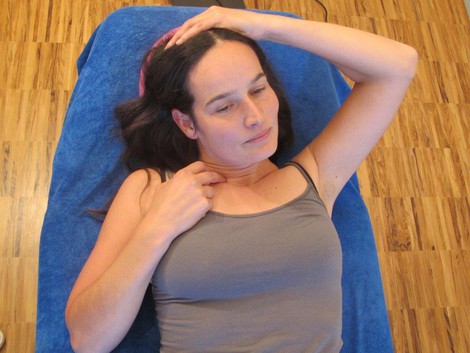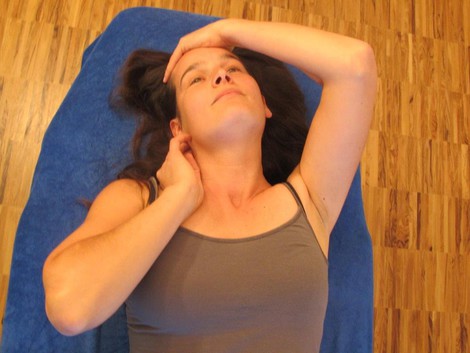Self-treatment of the atlas as well as the cervical and upper thoracic vertebrae and ribs
Anatomy and physiology
The atlas is our upper cervical vertebra and the bony connection between the spine and the skull. Together with the axis, the atlas forms the upper cervical joints.
These are anatomically and functionally connected to the whole body, down to the feet and up to the eyes, ear and jaw via the muscle-fascia connections.
There is also a connection within the spine to the sacrum and coccyx via the hard meninges in the spine.
Misalignments of the upper cervical joints can occur traumatically, even during childbirth, or due to asymmetrical tension in the jaw or trunk muscles, especially in the pelvis.
Pelvic twists and leg length differences in particular automatically lead to a misalignment of the atlas, as the body always tries to keep the gaze horizontal. In the most common form of pelvic twisting with rotation of the whole body to the right, there is a corresponding shift of the atlas to the left, unless an irritation in the upper thoracic spine area on the right at the 2nd-4th rib interrupts the myofascial connection.
In any case, the entire fascial apparatus of the body as well as the superordinate autonomic nervous system and its potential sources of interference should be included in the treatment.
Misalignments, asymmetries, tensions and blockages in the area of the foot and other leg joints, the torso and the head, in particular the jaw or different vision in the eyes can also cause misalignments and tensions in the area of the head joints with corresponding effects on all psychosomatic levels.
The misalignment of the atlas can also lead to a persistent fixation in sympathetic tone, or stress mode, due to pressure on the most important nerve of the parasympathetic nervous system, the vagus nerve, which runs in front of the atlas, with corresponding effects on the entire fascial system, on the autonomic or vegetative nervous system and thus also on the immune system and the self-healing and regulatory powers (see stress).
You can use the Integral Stress Test to determine whether the atlas blockage is responsible for the stress mode with pelvic twisting: Touching the atlas with the hand placed under the upper neck then releases the pelvic twisting.
Self-treatment
1. relief of pelvic twisting:
To relieve the pelvic region, first carry out the techniques described under Pelvic twisting and sacral integration (see under Pelvic twisting and integration techniques).
Upper thoracic spine and ribs:
„Blockages“ or irritations of the vertebral joints are indicated by a pressure-painful hardening in the groove next to the midline, i.e. next to the spinous processes of the vertebrae.
For orthobionomic relief of blockages in the upper thoracic spine, the opposite shoulder is lifted to the respective tension point next to the spine until it dissolves.
To examine and relieve the ribs, first press on the rib attachments next to the breastbone. Take the most painful point, in this case usually the 4th rib on the right, slightly above the nipple. Then your partner uses their other hand to find the origin of this rib next to the spine. This is usually also painful under pressure. You can recognize the correct point by the fact that the pressure pain immediately disappears at the front. Remain in this position until the pressure pain, which may increase at first, also disappears at the back. Then use your palpation finger to find the neighboring joint of the rib at the transverse process of the vertebra. It is about 3 cm further out. If there is pressure pain, hold or press this joint for a while.
A blockage of the 4th rib on the left is often responsible for cardiac arrhythmia, including atrial fibrillation and fluctuations in blood pressure.
The ribs above are often responsible for shoulder, arm and headaches.
Cervical spine
Treatment of the cervical spine is then carried out in the supine position.
To treat the middle and lower cervical spine joints, the neck is first placed on a pillow and tilted in the direction of the side of the neck that is painful.
While the hand lies at the side of the neck and the fingertips touch the area of pain, the index or middle finger of the other hand is used to gently push the navel in the most comfortable and softest direction.
To release blockages and tension in the upper cervical spine, the neck is placed in a slightly overstretched position and tilted and rotated in the direction of a joint or muscle with pressure pain until the pressure pain is relieved.
To relieve the atlas, look for the transverse process causing the pressure pain behind a somewhat prominent bone, below the ear. In this position, use the other hand to gently turn the back of the head backwards in the direction of the touch finger by „smoothing“ the forehead folds upwards from the top of the head.
The upper cervical joints can also be relaxed by gently holding the transverse process of the first vertebral body (= atlas) on both sides in the fossa under the ear with the middle finger.
To treat the upper vertebrae and the atlas, the neck is tilted back until the pressure pain at the side of the vertebral joint or, in the case of the atlas, at the transverse process at the bottom, behind the ear, is significantly reduced. In this position, light pressure is then exerted with the other hand from above on the head in the direction of the back of the head and held until the pressure-painful tension over the „blocked“ vertebra is completely relieved. The direction of movement and strength of pressure corresponds to smoothing out the wrinkles on the forehead.
For dizziness, tinnitus and headaches, it is particularly important to relax the second cervical vertebra and the head nodule (see below).
Jaw and neck relief
If there is pressure pain in the area of the temporomandibular joint, the lower jaw is gently moved sideways in the direction in which the pressure pain dissipates. The ball of the hand is used to gently hold the lower jaw in this position while the fingertips touch the upper neck, the palm of the hand lies over the tonsil region from the outside and the other hand gently pushes the navel in the most comfortable and softest direction with the index or middle finger. On the opposite side, this position is only held without moving the lower jaw. If you find your hand on the neck uncomfortable, first relieve the aura of the neck and heart by holding your arms outwards as if you were hugging a large ball. In Qi Gong, this position is called „the tree“. You should also adopt this position regularly to relieve stress.
Relief of the posterior muscle-fascia connections and the head joints
The eye muscles are coordinated with the occipital muscles. To relax the eye muscles or the occipital muscles via the eyes, both palms can be gently placed on the eyeball and the eyes gently pushed together in a comfortable direction.
Follow-up treatment
To stretch the muscles at the back of the neck, pull your head forwards with both hands while holding your elbows apart. Stretch the side of your neck by pulling your head to the side and forwards with your arms and wrists stretched backwards on the opposite side. To strengthen the neck, push your head in an upright position against the resistance of your own hands in all four directions and with your chin to the side.

Relief of the attachment of the anterior muscle-fascia connection with the sternocleidomastoideus

Relief of the attachment of the posterior muscle-fascia connection with simultaneous positioning of the atlas with finger contact on the transverse process of the atlas behind the ear and slight hyperextension of the neck
